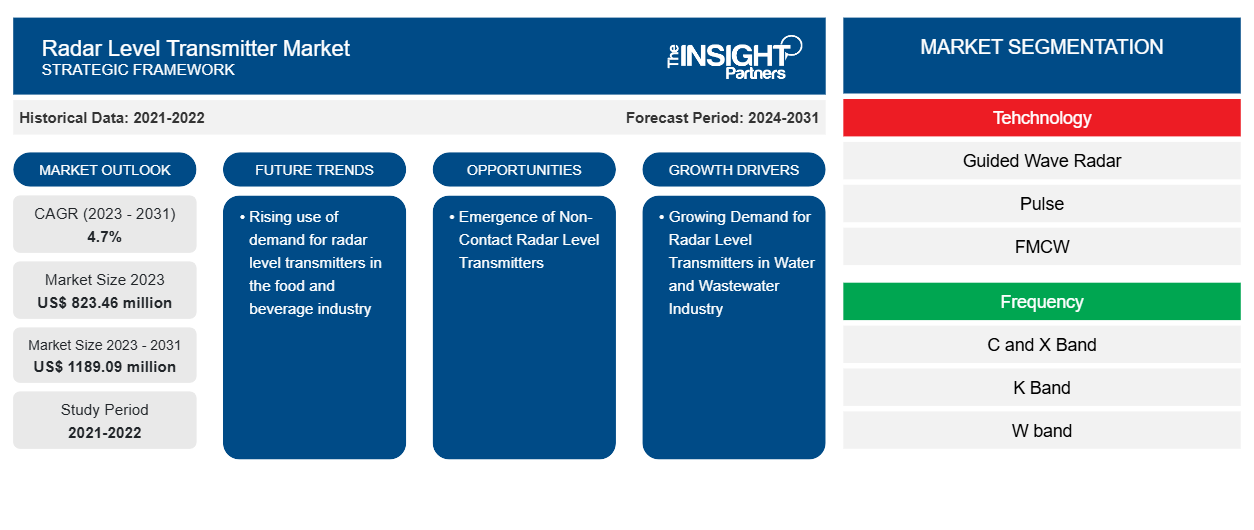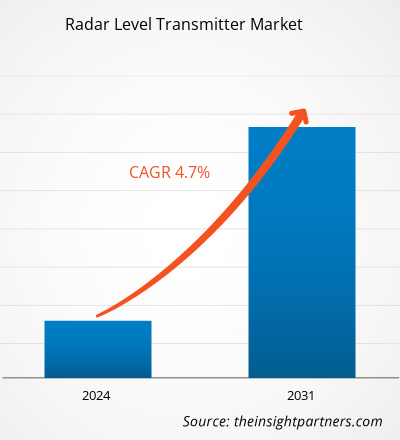The radar level transmitter market size is projected to reach US$ 1189.09 million by 2031 from US$ 823.46 million in 2023. The market is expected to register a CAGR of 4.7% in 2023–2031. The growing demand for radar level transmitters in the food and beverage industry is likely to remain a key market trend.
Radar Level Transmitter Market Analysis
The radar level transmitter market is growing due to the benefits of high stability, dependability, and precision offered by these transmitters. In addition, increasing emphasis on asset optimization and effectiveness is boosting the growth of the market at a global level. Furthermore, there is a growing demand for wireless radar level transmitters, especially for applications in remote areas within the mining, oil and gas, and chemical and petrochemical sectors, which is further propelling the growth of the radar level transmitter market. Moreover, expanding industrial and economic improvements in emerging economies are creating new opportunities for market players to provide more advanced solutions to their customers, further boosting the growth of the radar level transmitter market.
Radar Level Transmitter Market Overview
Radar level transmitters are electronic devices used for measuring fluid levels. These level transmitters help to detect fluid levels using radar technology. Numerous industries, including food and beverage, manufacturing, construction, oil and gas, and industrial, make extensive use of radar level transmitter technology. This technology is based on calculating the time required to complete a trip between the transducer and the measured material level. Radar level transmitters are best suited for tough environments when mist, dust, or a foamy surface inhibits the use of an ultrasonic transmitter.
Customize This Report To Suit Your Requirement
You will get customization on any report - free of charge - including parts of this report, or country-level analysis, Excel Data pack, as well as avail great offers and discounts for start-ups & universities
Radar Level Transmitter Market: Strategic Insights

-
Get Top Key Market Trends of this report.This FREE sample will include data analysis, ranging from market trends to estimates and forecasts.
Radar Level Transmitter Market Drivers and Opportunities
Growing Demand for Radar Level Transmitters in Water and Wastewater Industry
The water supply sector is being pressed to advance water treatment techniques as the requirement for consistent water quality grows, and the management of water quality becomes more strict and harsh. Radar level transmitter technology is a very economical alternative for water projects and is capable of measuring levels in harsh conditions. During the wastewater treatment process, selecting the appropriate wastewater level transmitter is essential. Radar level transmitters are used to monitor wastewater levels at each stage of the wastewater network and treatment technique, providing crucial control and process input, which is fueling the growth of the radar level transmitter market globally.
Emergence of Non-Contact Radar Level Transmitters
Non-contacting is a better fit for unclean, viscous, and corrosive applications, as well as when agitators are used. Non-contact radar transmitters use frequency-modulated continuous wave (FMCW) technology to assess levels. Furthermore, these transmitters are used to improve measurement precision and reliability and can be used for a wider range of applications. Moreover, the accuracy remains unaffected by variations in media density, temperature, dust, and pressure, which is further expected to create an opportunity for the growth of the radar level transmitter market.
Radar Level Transmitter Market Report Segmentation Analysis
Key segments that contributed to the derivation of the radar level transmitter market analysis are technology, frequency, medium, and industry vertical.
- Based on technology, the radar level transmitter market is segmented into guided wave radar, pulse, and FMCW. The guided wave radar segment held a larger market share in 2023.
- By frequency, the market is segmented into C&X band, K band, and W band. The C&X band segment held the largest share of the market in 2023.
- By medium, the market is segmented into solid and liquid. The solid segment held the largest share of the market in 2023.
- By industry vertical, the market is segmented into oil and gas, chemicals, food and beverage, and others. The oil and gas segment held the largest share of the market in 2023.
Radar Level Transmitter Market Share Analysis by Geography
The geographic scope of the Radar Level Transmitter Market report is mainly divided into five regions: North America, Asia Pacific, Europe, Middle East & Africa, and South America/South & Central America.
MEA is witnessing tremendous growth of radar level transmitters because of its tremendous use in the oil and gas and chemical sectors. As the region is one of the largest producers of oil & gas, the demand for this transmitter is increasing. According to the International Trade Administration, the United Arab Emirates is one of the top ten largest oil producers in the world. About 96% of the country’s oil reserves, around 100 billion barrels, are in Abu Dhabi. Similarly, Saudi Arabia has approximately 17% of the world’s proven petroleum reserves, making the country one of the largest exporters of petroleum. Also, the country has the second-largest proven oil reserves in the world. Furthermore, the governments of the above countries are taking various initiatives to increase the production of oil and petroleum, which is further fueling the growth of the radar level transmitter market.
Radar Level Transmitter Market Regional Insights
The regional trends and factors influencing the Radar Level Transmitter Market throughout the forecast period have been thoroughly explained by the analysts at The Insight Partners. This section also discusses Radar Level Transmitter Market segments and geography across North America, Europe, Asia Pacific, Middle East and Africa, and South and Central America.
Radar Level Transmitter Market Report Scope
| Report Attribute | Details |
|---|---|
| Market size in 2023 | US$ 823.46 million |
| Market Size by 2031 | US$ 1189.09 million |
| Global CAGR (2023 - 2031) | 4.7% |
| Historical Data | 2021-2022 |
| Forecast period | 2024-2031 |
| Segments Covered |
By Tehchnology
|
| Regions and Countries Covered |
North America
|
| Market leaders and key company profiles |
|
Radar Level Transmitter Market Players Density: Understanding Its Impact on Business Dynamics
The Radar Level Transmitter Market is growing rapidly, driven by increasing end-user demand due to factors such as evolving consumer preferences, technological advancements, and greater awareness of the product's benefits. As demand rises, businesses are expanding their offerings, innovating to meet consumer needs, and capitalizing on emerging trends, which further fuels market growth.

- Get the Radar Level Transmitter Market top key players overview
Radar Level Transmitter Market News and Recent Developments
The Radar Level Transmitter Market is evaluated by gathering qualitative and quantitative data post primary and secondary research, which includes important corporate publications, association data, and databases. The following is a list of developments in the market for speech and language disorders and strategies:
- KROHNE, Inc. announced the addition of three 24 GHz and three 80 GHz OPTIWAVE Radar Level transmitters to its product line, which complement the existing 10 GHz devices. The entire range of OPTIWAVE 2-wire loop-powered FMCW radar level transmitters for liquids and solids is ideally suited to industries from chemical and petrochemical to mining, minerals, and metals processing and covers liquid and solid applications. (Press Release, 2022)
- Emerson announced the development of the Rosemount 1408H Level Transmitter, the world’s first non-contacting radar device designed specifically for the food and beverage industry. Dedicated features include a hygienic compact design, fast sweep technology, exceptional radar beam focusing, and IO-Link communications, helping manufacturers optimize the efficiency of their operations, reduce product losses, and ensure food safety. (Source: Emerson, Press Release, 2021)
Radar Level Transmitter Market Report Coverage and Deliverables
The “Radar Level Transmitter Market Size and Forecast (2021–2031)” report provides a detailed analysis of the market covering below areas:
- Market size and forecast at global, regional, and country levels for all the key market segments covered under the scope
- Market dynamics such as drivers, restraints, and key opportunities
- Key future trends
- Detailed PEST/Porter’s Five Forces and SWOT analysis
- Global and regional market analysis covering key market trends, major players, regulations, and recent market developments
- Industry landscape and competition analysis covering market concentration, heat map analysis, prominent players, and recent developments
- Detailed company profiles
Frequently Asked Questions
What are the driving factors impacting the global radar level transmitter market?
What is the estimated market size for the global radar level transmitter market in 2023?
What are the future trends of the global radar level transmitter market?
What will be the market size of the global radar level transmitter market by 2031?
Which are the key players holding the major market share of the global radar level transmitter market?
- Historical Analysis (2 Years), Base Year, Forecast (7 Years) with CAGR
- PEST and SWOT Analysis
- Market Size Value / Volume - Global, Regional, Country
- Industry and Competitive Landscape
- Excel Dataset
Recent Reports
Related Reports
Testimonials
Reason to Buy
- Informed Decision-Making
- Understanding Market Dynamics
- Competitive Analysis
- Identifying Emerging Markets
- Customer Insights
- Market Forecasts
- Risk Mitigation
- Boosting Operational Efficiency
- Strategic Planning
- Investment Justification
- Tracking Industry Innovations
- Aligning with Regulatory Trends





















 Get Free Sample For
Get Free Sample For